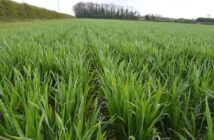Poor weather and soil conditions has meant a delay in drilling for some of the spring barley in this year’s virtual Cereals Challenge, reflecting the real time challenges that many growers and agronomists have faced this spring.
The Cereals Challenge was established eight years ago to encourage a new generation of agronomists and farmers into the industry. Organised by crop production specialists Hutchinsons and farm business management company Velcourt, the Challenge is aimed at agricultural students from the UK’s leading universities and colleges, by offering them a virtual crop to manage.
Reflecting the return to spring cropping that many growers have found themselves in this season as a result of increasing battles against black-grass and the challenges facing the OSR crop, the eight teams in this year’s challenge are competing to grow the best crop of spring barley.
At the Challenge launch in February, teams were able to choose between two virtual on farm scenario’s in which to grow their barley: either as a high yielding feed crop on heavy soil in a black-grass situation, or as a moderate yielding malting crop on sandy soil with moisture limitations.
Since then each team has had complete responsibility for their crop – from choosing which variety to grow and drilling details through to making the real-time agronomy decisions on inputs right through until harvest when they will be required to estimate crop yield and quality – and all with the final gross margin in mind, says Paul Hobson of Hutchinsons.
The Riseholme College team opted to grow KWS Irina on sandy soils as they felt that the black-grass burden would be less of an issue. “However, the dry spring has meant that we had to delay drilling, and we increased our seed rate from 151kg/ha up to 198kg/ha to compensate for this, with a final plant population target of around 400 plants/m².
“We also dropped the pre-emergence application of Stomp Aqua that was planned due to the later drilling, as the product is not approved to be applied any later than the end of March,” says team captain, Benjamin Hargrave.
“There has been a lot of discussion about fertiliser as we believe that the sandy soils could have a manganese deficiency. We had planned to apply 15% manganese at GS12-13 and a later dose at GS 31, but with the delayed drilling we opted for a seed dressing containing manganese.”
The team from Newcastle chose to grow Scholar and push for malting quality. They pushed back their original drilling date by a week, and had already planned to use a higher seed rate of 450 seeds/m².
“We aimed for very low soil disturbance at drilling to minimise black-grass germination using a Disc Coulter drill, followed by rolling. We planned for a strong pre-emergence herbicide programme so that we were on top of any black-grass early, with the aim of getting the barley well established to increase the crop’s competitiveness against the black-grass,” says Nick Lount.
Like any real time agronomists, the teams will now need to continue to manage their plots going through until Cereals, ensuring that they respond to any particular crop or seasonal events. The last stage of the Challenge requires them to think about their final fungicide recommendations – and then think about what the final crop yield and quality will be like as a consequence of their recommendations.
Nick Sanderson from Askham Bryon College in York believes that the Challenge offers a really good opportunity to test agronomy skills within a set time frame. “We hope to gain valuable experiences from working with representatives from industry-leading companies such as Hutchinsons and Velcourt, as well as learning from the other teams.”
The winning team will be announced at the Cereals Event, at 5pm on Wednesday 14th June at the Hutchinsons stand (no 926). Follow the 2017 Cereals Challenge on Twitter @CerealChallenge where you can meet the teams and keep up-to-date with what is happening on the plots.




